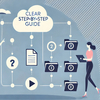Do you like/read comic books? If the answer is ‘no’, you might learn a thing or two from this post. Not just about comic books but why so many people find them captivating and what technical writing can borrow from that concept. If you are into comic books, then you already understand their potential in transmitting information in a very clear and entertaining manner.

The Dawn of Superheroes
On September 25, National Comic Books Day is celebrated. It is a great occasion to look into this phenomenon that occurred in 1933 when the first real comic book was published. That book was called ‘Famous Funnies’ and it was basically a reprint of newspaper comic strips. Those strips, by the way, established the basic characteristics modern comic books possess.
As comic books developed, the ‘comic’ part faded away slowly. You can find humorous series of books of course, but some comic books went in a completely different direction. They can get really dark, dramatic and serious.
Comic books resemble anime in the sense that anyone can find a genre they like. But the general audience mostly knows about superhero comic books. This is very much understandable since the US is where these books were born and the superhero concept ties in well with the American overview of the world and justice in it.
Nowadays, the comic book industry is huge. It has prominent corporate players and many smaller publishers trying to make it. Movies, video games, collectibles, merch…this industry has it all. If we look for reasons behind this success we will get closer to the title of this blog article.

Comics as a Means of Transmitting Information
Okay, so, what do we have here? Believe it or not, turns out comics have a lot of characteristics that make them perfect for certain tech writing scenarios.
Firstly, comics are visual manifestations of data. They can include written text, but the images are still dominant. Pictures are much easier to digest. In user manuals, screenshots, graphs and schemes act as elements supporting text, making it easier to comprehend. Comics can’t be used for explaining complex technical details, for sure, but they fit very well into another niche.
Comics are great for illustrating simple concepts and can easily replace boring introductions for apps, software, and services (by the way, check out these awesome comics as an example of how fitting they can be in the technical world when used right). Although, that largely depends on how your company would like to be seen by others as comics will add both gamification and a certain playful tone that might not be what you are going for. It is necessary to mention that the trend of being more friendly with clients is still going, so using comics might be the turning point for your company.
So, it is true, comics make your image more positive and amiable. It also gets more personal. A great way to show your clients that they can relax as the people behind the products they are using are actually pretty nice and have an excellent sense of humor, or at least they are entertaining 🙂
Using comics can save you money. Specifically, localization money. The example that simply can’t be ignored is IKEA. The IKEA team had worked really hard and they managed to create the almost-perfect technical documentation in the pictorial form with almost no text which saves them crazy amounts of money since they are selling worldwide with no need to translate assembly instructions.
Conclusion
Now, you see that there’s another side to comic books, the one that is closely connected with technical communication. Of course, implementing comics is not the easiest process for a technical writing team to go through. But if you feel like this format of communicating with clients can be fitted into your company strategy, then it is something you should definitely consider.
Good luck with your technical writing!
ClickHelp Team
Author, host and deliver documentation across platforms and devices



